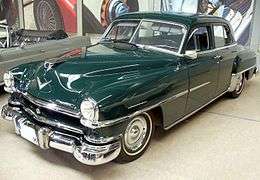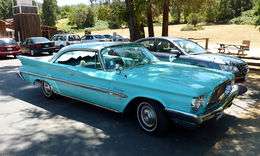Chrysler Saratoga
The Chrysler Saratoga is an automobile built by Chrysler. Chrysler used the Saratoga nameplate from 1939 to 1952 and from 1957 to 1960 in the U.S. market, in Canada through 1965, and in Europe from 1989 to 1995.
1939–1942
The Saratoga nameplate first appeared in 1939 and was applied to Chrysler's most expensive full-size eight-cylinder models, above that of the Imperial and the New Yorker. It was available as a four-door sedan and the Hayes-bodied club coupe. Sedan prices for the 1939 C23 eight-cylinder sedans were Imperial US$1,198, New Yorker US$1,298 and Saratoga US$1,443. Full wheel covers were standard on the Saratoga.
In 1940, Chrysler assigned the Saratoga to its Series C26 eight-cylinder models, along with the Traveler, which replaced the Imperial, and New Yorker models. For 1940, the car was available only as a four-door sedan, and in two interior configurations, standard and sport formal. The latter had a glass partition behind the front seat which could be lowered. Fluid Drive was offered for the first time, mated to a three-speed manual transmission.
In 1941, the Saratoga was assigned to Chrysler's Series C30 and was demoted to the bottom of the eight-cylinder series, replacing the Traveler. Body styles offered expanded to include a business coupe, club coupe, two-door sedan and four-door Town Sedan, as well as the six-window sedan. This the Saratoga offered Fluid Drive and the eight-cylinder version of Vacamatic which consisted of a three-speed transmission mated to an overdrive unit.
The 1940 Saratoga models were still offered, but now under the name of Imperial Crown Special.
For 1942 the Series C-36 Saratoga was again available only with an eight-cylinder engine along with the same transmission selections as in 1941. Selection of body styles also remained as in 1941.
1946–1952

The Saratoga nameplate returned for 1946, positioned as Chrysler’s least expensive eight-cylinder model, in a full array of body styles, and was related to the Chrysler Windsor and the DeSoto Custom. Annual styling changes were almost non-existent between 1946 and the "First Series" 1949 Chryslers. Because of government restrictions on manufacturer source goods, Chrysler offered white steel "beauty rings" on its car wheels to give the appearance of wide white wall tires. White wall tires as an option returned in 1947. Fluid Drive continued but the four speed semi-automatic was now offered.
When the fully redesigned 1949 "Second Series" Chryslers bowed in mid-season, the Saratoga was once again regulated to two body styles, the four-door sedan and two-door club coupe, and shared the 131.5 inch wheelbase and straight-eight engine of the Chrysler New Yorker. The semi-automatic was now called Prestomatic on Chryslers. Saratoga production for 1949 came to 2,475 vehicles in total.
1950 models received new grilles, taillights and a larger rear window. Production dropped to 1,300 cars.
For 1951 the Saratoga was built on the shorter 125.5 inch wheelbase but offered the Chrysler's famed 331ciHemi V8. Also offered was Hydraguide power steering, an industry first, and Fluid Torque Drive, a true torque converter in place of Fluid Drive's fluid coupling.
Model selection also increased for 1951 with a wagon plus eight-passenger sedan and limousine on the 139.5 inch wheelbase added. This combination of the shorter, lighter Six body and the powerful new V-8 put the new Hemi Saratoga in the same performance league as the Olds Rocket 88, but was the quicker car. 1951 proved to be a great year with 34,806 cars built.
1952 brought new taillamps while the limousine was dropped. Due to the Korean War, production dropped to 17,401 for the 1952 model year. A further 1,300 Saratoga models were built in Canada, the first eight-cylinder Chryslers to roll out of the Windsor plant since 1937.
For 1953 the Saratoga was renamed New Yorker while the old New Yorker would be New Yorker DeLuxe. The Saratoga name would reappear for 1957.
1957–1965
1957–1960

Chrysler reused the Saratoga nameplate in 1957 as part of its "Forward Look" styling by Virgil Exner. Again, the Saratoga was positioned between the base Windsor and top New Yorkers models, and was related to the DeSoto Firedome, but received trim upgrades and better appointments inside the passenger compartment. The base V8 in the Saratoga was a cast-iron poly head block V8 shared with the Windsor. Chrysler’s highly praised Hemi was not available as an option. Early 1957 models featured dual headlights, with quad-headlights as an option where permitted by state law. By the model year's end all Saratogas were outfitted with quad headlights.
For 1958, all Windsors were shifted to the 122 inch Dodge chassis, and used a modified front end design based in part on Dodge's front clip - this was especially evident around the Windsor's headlights. Saratogas continued to be based on the longer 126 inch wheelbase using the New Yorker body and was again available in three body styles – four-door sedan, four-door hardtop, and two-door hardtop coupe.
In Canada, the 1957–1958 Saratoga was sold as the Windsor. The American Windsor was not sold in Canada although Windsor station wagons were imported.
In 1959, the Saratoga remained on the longer Chrysler wheelbase and in the same three models. The Saratoga was sold as the Saratoga in Canada this year, sharing its interior with the Canadian-built DeSoto Firedome. For 1959 the Saratoga got the new RB V8 engine, although it was the Chrysler-only 383-cid in 1959 and 1960. Canadian-built 1959–1960 Saratogas used the B block 383 as used by Dodge and DeSoto.
In its final year in the U.S., the 1960 Chrysler Saratoga was based wholly on the New Yorker body shell, less New Yorker trimmings, and again offered in three body styles – four-door sedan, four-door hardtop, and two-door hardtop coupe. Some 15,525 1960 Chrysler Saratogas rolled off the assembly line.
.jpg) 1957 Chrysler Saratoga 2-Door Hardtop
1957 Chrysler Saratoga 2-Door Hardtop.jpg) 1958 Chrysler Saratoga 4-Door Sedan
1958 Chrysler Saratoga 4-Door Sedan.jpg) 1959 Chrysler Saratoga 2-Door Hardtop
1959 Chrysler Saratoga 2-Door Hardtop.jpg) 1960 Chrysler Saratoga 2-Door Hardtop
1960 Chrysler Saratoga 2-Door Hardtop
1961–1965

In 1961, Chrysler decided to release a new low-price entry-level model called the Chrysler Newport for the American market, a name which in 1961 was commonly associated with Chrysler’s expensive hardtops in the early and mid 1950s to take the market segment left open when Chrysler's DeSoto brand was cancelled. While the Newport took the place of the Windsor in the lineup, the company cancelled the mid-range Saratoga, and elevated the Windsor name to the mid-level position.
In Canada the Saratoga continued on through to 1965 with the Windsor line remaining on the bottom. Thus the Canadian 1961 Saratoga was basically the U.S. Windsor with Saratoga nameplates on the 122 inch wheelbase.
For 1962 Canadians did not get the new 300, but instead got the Saratoga. The grille was shared with the Newport/Windsor while the side trim was from the American Newport. The trunk lid sported New Yorker trim. Model offering remained 4-door sedan and hardtop plus 2-door hardtop.
New bodies appeared for 1963 with the Canadian Saratoga using the same grille and trim as the U.S. 300, only with "Saratoga 300" nameplates, as the series was now called. Body styles remained the same and this year the 300 convertible was imported.
Although the American 1964 300 continued to use the 1963 headlamp rings, the Canadian Saratoga 300 used the headlamp treatment of the Newport/Windsor, and had 300 side trim. The American 300 convertible continued to be an import.
1965 brought completely new "C" bodies on a 124 inch wheelbase. Again, the Canadian Saratoga 300 was identical to the U.S. 300. This was the last year for a Saratoga sold in North America.
For 1966 the mid-range Chrysler series in Canada was sold as the 300, except it used Newport/Windsor taillamps. The same three models continued, but this year the American 300 convertible and two-door hardtop were imported and marketed as the Sport 300.
1989–1995


The Saratoga name was revived in 1989 when Chrysler rebadged its Dodge Spirit sedan for export to Europe. Marketing of this Saratoga was officially discontinued in 1993, but the Saratoga continued being built and exported, and parts unique to it continued being catalogued through the 1995 end of A-body production.
These export-market Saratogas were not simply Dodge Spirits with different nameplates. Differing vehicle safety regulations in the rest of the world versus North America required the Saratoga to have different headlamps and front, side, and rear lights and reflectors, glass, mirrors, seat belts, instrument clusters and radios; engine control units were programmed in accord with European emission standards rather than the North American standards. All Saratogas featured front bucket seats. Basic equipment included the 2.5 L 4-cylinder engine with throttle-body fuel injection and a 5-speed manual transmission; the most commonly ordered powertrain upgrade was the Mitsubishi 3.0 L V6 with A604 Ultradrive 4-speed automatic transmission, though the turbocharged version of the 2.5 was also available with 3-speed Torqueflite automatic or 5-speed manual transaxle. Starting in 1993, the Saratoga was available with leather seats and other luxury equipment not provided in the North American market. Most 1993 and later Saratogas were equipped with the V6/4-speed automatic powertrain. All Saratogas were equipped with the highest-specification suspension and brake systems made by Chrysler for the A-body.
The last Saratogas, sold in 1994 and 1995, were based on the US-market Chrysler LeBaron Sedan. They can be identified by additional fender chrome and an "LE" badge on the trunklid. These models were all equipped with the 3.0 liter Mitsubishi V6, the A604 automatic transmission, leather seats and air conditioning. Saratoga production ended on December 9, 1994.
External links
| Wikimedia Commons has media related to Chrysler Saratoga. |
- IMCDB: Chrysler Saratogas in movies & TV shows
- Saratoga Common Technical Page (for 1989–1995 export-market Saratogas)